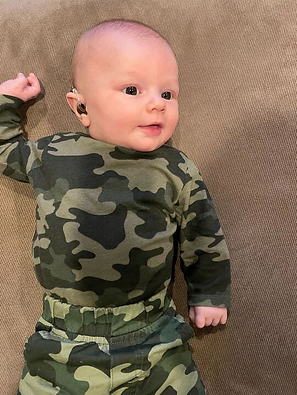
Evaluation By A
Pediatric Audiologist
You are at a critical stage of the Roadmap. If your child has not passed the newborn hearing screening (this can be done up to two times in the hospital) and the outpatient rescreen (once your child is discharged), this next step will determine if your child has a diagnosable hearing difference. It is important for you to follow through, and think about who should be at this next appointment with you. You don’t need to automatically assume that your child has a diagnosable hearing difference, but this appointment should get you the answers you need.
“I wish I had known that this was the appointment that we would find out for sure that my daughter had a hearing loss or not. I kind of got lost in the process, and when I took our baby for this testing appointment, my husband was at work, and when the audiologist announced that our daughter had a permanent bilateral hearing loss, I was all alone.”
- A Colorado mom.
Diagnostic Audiology
When children with hearing difference receive timely and appropriate diagnostic and intervention services, they can have positive speech, language and listening outcomes. The diagnostic hearing evaluation should be performed by a pediatric audiologist who has the technical expertise and desire to work with infants and children. They perform a series of tests to determine the type (part of the ear affected), degree (how much hearing loss exists) and configuration (frequency or pitches that are affected) of a child’s hearing difference.
It is important to note that not all children are canadiats for certain types of amplification, and your audiologist should also discuss your family's language options with you, or direct you to supports for more answers.
Types of Hearing Tests for Infants & Children
Otoacoustic Emissions (OAE)
A cochlea that is functioning typically not only receives sound, it also produces low intensity, measurable sounds called OAEs. This particular test measures the sound being sent out from the inner ear. A tiny, flexible microphone is placed in the ear canal and the return sounds are analyzed by a computer. It is important to note that middle ear fluid or wax buildup can affect the outcome of the test. The infant or child should be sleeping or resting quietly for the best test results.
This test gives accurate and reliable information about the condition of the inner ear (cochlea) and the auditory nerve. While the baby is sleeping, non invasive electrodes (wires) are attached to the scalp and clicking sounds are made through tiny earphones in the baby’s ears. A computer measures the very tiny electrical signals caused by nerves firing in the auditory nerve and brainstem. The results of an ABR allow an audiologist to determine the most beneficial path towards access to sound (hearing aids, bone conduction hearing aids, and/or cochlear implants). Generally, children under 6 months do not need sedation for this test. If your child does need to be sedated to ensure a deep sleep and an uninterrupted test, it must be done under hospital staff supervision.
How to have a successful ABR evaluation:
Keep your baby awake until quite late the night before the test (sleep-deprived) to ensure a sound sleep· Try to feed your baby just before the testing so baby is relaxed, happy and sleepy (this can often be done at the facility). Bring a blanket or stuffed toy that your baby is familiar with so they feel more comfortable during the test. Allow for a block of time that may go beyond your scheduled time slot (sometimes more time is needed to complete the testing).
If you are having a sedated ABR, remember to:
Follow the audiologist instructions very carefully on what baby may eat before the testing· Do not give your baby any sedation (over the counter medications or prescriptions) before arriving for the ABR · Complete the informed consent form and bring it with you to the hospital.
Auditory Brainstem Response (ABR)
Tympanometry (Tympanogram)
This test is used to assess the condition of the middle ear, movement of the eardrum (tympanic membrane) and the conduction of the middle ear bones by creating variations of air pressure in the ear canal. It does not measure hearing. A flat test result can mean there is fluid in the middle ear, indicating an ear infection. This can be a difficult test for younger children who are awake because they need to sit very still and not be crying, talking or moving.

